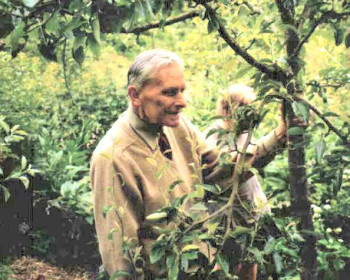
Robert Hart's forest garden
 Robert
Hart began his adventures in forest gardening as a plain old
back-to-the-lander like us. He had a twenty acre farm in England,
most of which was pasture. There he ran poultry, goats, sheep,
cattle, and bees, but he soon found the inevitable slaughter involved
in livestock-rearing to be too much and became a vegan.
Robert
Hart began his adventures in forest gardening as a plain old
back-to-the-lander like us. He had a twenty acre farm in England,
most of which was pasture. There he ran poultry, goats, sheep,
cattle, and bees, but he soon found the inevitable slaughter involved
in livestock-rearing to be too much and became a vegan.
Hart's forest garden was
a replacement for the food he had once gotten from his livestock.
He focused on a one acre tract beside his house and began
planting. About an eighth of the garden was an old orchard, full
of apples, pears, and damsons (plum-like fruits), while the rest of the
area was originally a traditional vegetable garden. Hart began
planting herbs and black currants in the understory of the orchard,
mulching heavily with with straw, compost, and grass clippings in the
spring and early winter. He quickly realized that the combination
of mulch and perennials made the forest garden much simpler to keep up
than the traditional vegetable garden, though he noted that he would
occasionally have to go on a "crawl-and-claw expedition through the
undergrowth" to weed.
Like traditional forest
gardeners in the tropics, Hart maintained sun-loving plants in a
different part of the garden. But he was able to grow a
surprising amount of food under and amid his trees --- masses of mints
and other herbs, his signature black currants (one
of the few temperate
plants that fruits exuberantly in the shade), and a host of wild
and
semi-wild vegetables like dandelions, nettles, and chicory. He
also grew patches of osier and willow that he allowed his neighbors to
coppice for use in basket-making.
| This post is part of our Robert Hart's Forest Gardening lunchtime
series.
Read all of the entries: |
Want more in-depth information? Browse through our books.
Or explore more posts by date or by subject.
About us: Anna Hess and Mark Hamilton spent over a decade living self-sufficiently in the mountains of Virginia before moving north to start over from scratch in the foothills of Ohio. They've experimented with permaculture, no-till gardening, trailersteading, home-based microbusinesses and much more, writing about their adventures in both blogs and books.
Want to be notified when new comments are posted on this page? Click on the RSS button after you add a comment to subscribe to the comment feed, or simply check the box beside "email replies to me" while writing your comment.
